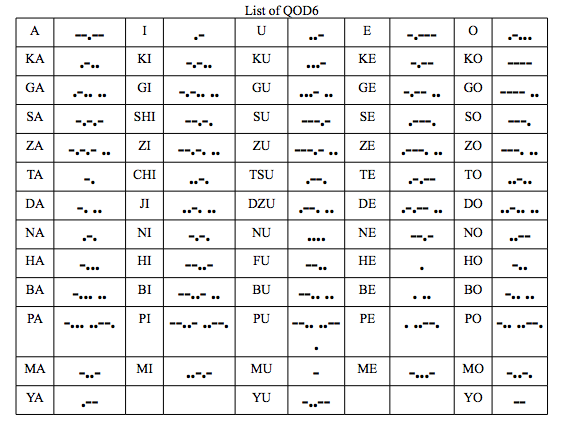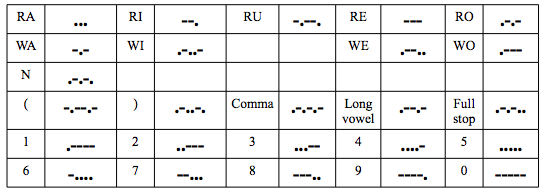|
|
刚开始学CW的时候,经常听到频率上的CQ DO(-..---)不明白怎么回事,请教过别人,最近也回复过一些别人的疑问,但总感觉解释得还不够准确,在BA5AD的指点下,用BING搜索日本的文章,这个写得很透彻转发过来。(用的网页翻译不一定很准确,但起码知道了DO是咋回事了) “ Wabun” –日本摩尔斯电码 发表于 2014年7月14日
“ WABUN” –日本摩尔斯电码(QOD6),MAI,JH1JDI –拳头#15123
我喜欢使用QOD6(日本摩斯电码,也就是所谓的“ Wabun CW”)进行QSO。“ Wabun”在日语中通常是指“日语”,在日语HAM中尤其是“ QOD6中的CW通信”。我喜欢Wabun CW QSO的原因是,即使在CW模式下,我们也可以用日语进行交流。根据2013年8月发布的Wabun CW电台目录,由Wabun CW爱好者业余协会组成,在日本大约有3900个业余电台在运营Wabun CW。如果记住Wabun莫尔斯电码(QOD6),对于日本的CW男人来说,发送他们想说的话和听到其他电台想说的话就容易了,因为Wabun的通讯是用母语进行的。在日本,似乎主要有三种类型的CW QSO。第一种是“ 599 BK”风格,第二种是使用QOD1(英语)聊天,第三种是使用QOD6聊天。由于传播的特性,Wabun CW QSO在80mb和40mb以及144MHz频带中很流行。80 mb和40 mb都非常适合与日本各地的电台联系,从冲绳(JR6)到北海道(JA8),而144MHz频段的半径在150公里以内。许多使用瓦文的日本CW电台都在广播中,尤其是在3515k Hz和3525 kHz,7015 kHz和7025 kHz以及144.070 MHz之间。Wabun的标记是DO和SN。DO表示“从这里QOD6开始”,SN表示“ QOD6已经结束”。Wabun CW的CQ调用方式为“ CQ CQ CQ DO DE(呼号)”。示例JH1JDI:CQ CQ CQ DO DE JH1JDI JH1JDI KJA1QRZ:JH1JDI DE JA1QRZ KJH1JDI:JA1QRZ DE JH1JDI DO(发送Wabun)SN JA1QRZ DE JH1JDI KJA1QRZ:JH1JDI DE JA1QRZ DO(发送Wabun)SN JH1JDI DE JA1QRZ K现在,Wabun CW QSO甚至在日本也不太流行,因为有必要重新记住QOD6。这使日本HAM花费更多的时间来记住50多个代码,并且它们与QOD1英语代码没有任何联系。也就是说,Wabun的“ A”是“-..”,“ KA”是“ .- ..”,“ SA”是“ -.-.-”,它们不是A,K, S等。这些复杂性和不合逻辑来自于日语书写系统的特性,但是对于用日语进行的CW通信而言,效率更高。  在DO和SN之间的Wabun CW中,他们使用相对正式的日语文学风格,并且QOD6中的业余站几乎没有缩写,尽管有专业站。示例QOD1:BT GA UR 579 57N QTH HR东京WX精细ES温度25C MI名称MAI HW?增强现实QOD6:(用日语)DO下午好,谢谢您给我打电话。您的信号与579 57N一起送到东京。现在考虑到这里的天气,天气很好,温度为25度。我叫MAI。序号在Wabun聊天的大多数站点都在放松和享受美好时光,没有堆狗,也没有记录与之联系的站点的日志条目的记录结果。由于一般Wabun QSO的关注方向,一个QSO通常至少需要10分钟。我还和一个车站聊天了大约一个小时。因此,即使某些电台可以使用Wabun代码,他们也不喜欢Wabun QSO。他们说,他们不太喜欢Wabun,因为与“ 599 BK风格”短-短CW QSO相比,一个QSO需要花费更多时间。还有人有时说,Wabun QSO不应该公开发布,因为它是国内代码,而不是国际代码,对于非JA站甚至JA站(如果不能使用Wabun的话),它是一种“密码”。关于QOD6 Wabun QSO在日本有很多支持和反对的观点,但是我认为Wabun应该被正确地估计而不是被遗忘。因为QOD6是一种珍贵的特性,尤其是对于日本的CW男子而言。在2014年期间,我每月撰写有关Wabun的文章在日本出版的月刊“ CQ Ham Radio”上的CW QSO课程。目标是从介绍到学习和培训,再到对它感兴趣但尚未开始的Wabun CW QSO。摘自Mai,JH1JDI撰写的《亚洲拳头通讯》 把原文也贴出来,这个更准确些: “Wabun” – The Japanese Morse Code Posted on July 14, 2014 在DO和SN之间的Wabun CW中,他们使用相对正式的日语文学风格,并且QOD6中的业余站几乎没有缩写,尽管有专业站。示例QOD1:BT GA UR 579 57N QTH HR东京WX精细ES温度25C MI名称MAI HW?增强现实QOD6:(用日语)DO下午好,谢谢您给我打电话。您的信号与579 57N一起送到东京。现在考虑到这里的天气,天气很好,温度为25度。我叫MAI。序号在Wabun聊天的大多数站点都在放松和享受美好时光,没有堆狗,也没有记录与之联系的站点的日志条目的记录结果。由于一般Wabun QSO的关注方向,一个QSO通常至少需要10分钟。我还和一个车站聊天了大约一个小时。因此,即使某些电台可以使用Wabun代码,他们也不喜欢Wabun QSO。他们说,他们不太喜欢Wabun,因为与“ 599 BK风格”短-短CW QSO相比,一个QSO需要花费更多时间。还有人有时说,Wabun QSO不应该公开发布,因为它是国内代码,而不是国际代码,对于非JA站甚至JA站(如果不能使用Wabun的话),它是一种“密码”。关于QOD6 Wabun QSO在日本有很多支持和反对的观点,但是我认为Wabun应该被正确地估计而不是被遗忘。因为QOD6是一种珍贵的特性,尤其是对于日本的CW男子而言。在2014年期间,我每月撰写有关Wabun的文章在日本出版的月刊“ CQ Ham Radio”上的CW QSO课程。目标是从介绍到学习和培训,再到对它感兴趣但尚未开始的Wabun CW QSO。摘自Mai,JH1JDI撰写的《亚洲拳头通讯》 把原文也贴出来,这个更准确些: “Wabun” – The Japanese Morse Code Posted on July 14, 2014
“WABUN” – THE JAPANESE MORSE CODE (QOD6), MAI, JH1JDI – FISTS #15123
I like to QSO using QOD6, the Japanese Morse codes, so-called “Wabun CW”. “Wabun” means “Japanese language” in Japanese generally and “CW communications in QOD6” especially among Japanese HAMs. The reason why I like Wabun CW QSO is that we can communicate with in Japanese language even in CW mode. According to “Directory of Wabun CW Stations”, published in August, 2013, by an amateur society of Wabun CW fans, there are around 3900 amateur radio stations operating Wabun CW in Japan. If remember Wabun morse code (QOD6) it is easier for Japanese CW men to send what they want to say and to hear what the other stations want to say because Wabun communications are done in their mother tongue.
In Japan, it seems that there are mainly three types of CW QSOs. The first type is “599 BK” style, the second one is chatting using QOD1 (in English) and the third one is chatting using QOD6. The Wabun CW QSOs are popular in 80mb and 40mb, plus 144MHz band, because of the characteristics of the propagation. Both 80 mb and 40mb are so suitable to contact with stations all over Japan, from Okinawa (JR6) to Hokkaido (JA8), and 144MHz band is for radius of within 150km. Many Japanese CW stations using Wabun are on the air especially between 3515k Hz and 3525 kHz, 7015 kHz and 7025 kHz and around 144.070 MHz.
A marker of Wabun is DO and SN. DO means “from here QOD6 starts” and SN means “QOD6 has ended”. The way to call CQ for Wabun CW is “CQ CQ CQ DO DE (callsign)”.
Example
JH1JDI: CQ CQ CQ DO DE JH1JDI JH1JDI K
JA1QRZ: JH1JDI DE JA1QRZ K
JH1JDI: JA1QRZ DE JH1JDI DO (sending Wabun) SN JA1QRZ DE JH1JDI K
JA1QRZ: JH1JDI DE JA1QRZ DO (sending Wabun) SN JH1JDI DE JA1QRZ K
Now the Wabun CW QSO is not so popular even in Japan because it is necessary to remember QOD6 newly. This makes Japanese HAMs to spend more time to remember more than 50 codes and they don’t have any connections with QOD1 English codes. That is, “A” of Wabun is “–.–” and “KA” is “.-..”, “SA” is “-.-.-“, they are not simple combination of codes of A, K, S and so on. These complexity and illogic come from characteristics of Japanese writing system but it is more efficient for CW communications done in Japanese language.
 
In Wabun CW, between DO and SN, they use comparatively formal literary style of Japanese language and there are almost no abbreviations in QOD6 for amateur stations, although there were for professional stations.
Example
QOD1: BT GA UR 579 57N QTH HR TOKYO WX FINE ES TEMP 25C MI NAME MAI HW? AR
QOD6: (in Japanese) DO Good afternoon and thank you for your calling me. Your signal comes with 579 57N to Tokyo. Now regarding weather here, it is fine and temperature is 25 degrees. My name is MAI. SN
Most of stations chatting in Wabun are relaxing and having good time, without any dog piles or getting results in recording number of log entries of stations contacting with them.
Because of the direction of interest of general Wabun QSO, they usually take at least 10 minutes for one QSO. I also chat for about an hour with a station. So some stations don’t like Wabun QSO even if they can use Wabun codes. They say that they don’t like Wabun very much because it takes much more time for one QSO comparing with “599 BK style” short-short CW QSO.
And the other sometimes says that Wabun QSO should not be on the air since it is domestic codes, not international ones and it is a kind of “cryptogram” for non-JA stations and even for JA stations, if they can not use Wabun.
There are many opinions both for and against about QOD6 Wabun QSO in Japan, but I think Wabun is to be estimated correctly and not to be forgotten. Because QOD6 is one of precious properties especially for Japanese CW men. During 2014, I am writing a monthly article about Wabun
CW QSO course on monthly magazine “CQ Ham Radio” published in Japan. The target is from introduction, through the learning and training, to enjoying Wabun CW QSO for whom being interested in it but not having started it.
From ASIA FISTS Newsletter written by Mai, JH1JDI [ 此帖被bg6gqe在2021-01-20 18:04重新编辑 ]
|